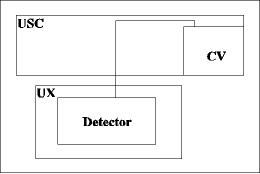
Temperature variation in ECAL regulating circuit along USC cavern
12/06/2001
=> Position of the problem
=> Modelisations
=> Results
=> Conclusions
The sub-detector ECAL of CMS requires water cooling with a great precision 18 ± 0.05 °C. It is a big challenge to provide the cooling with this specifications.
The detector itself is placed in a cavern (UX) and all the services, including the cooling, have to be placed in an adjacent cavern (USC).
As it is now, we will have to produce the precise flow in the CV (cooling and ventilation) zone of the USC and bring it to the detector via USC and UX. If we suppose that the required flow and temperature precision are achieved inside the CV zone of the USC, we want to know if the precision will stay the same until the detector (where it is required).
This paper will study the influence of the air ventilation inside the cavern. The air temperature in the cavern can change due to the variation of the atmospheric conditions.

Characteristics of the pipes path:
| Length | 100 m |
| Diameter | DN 200 i.e. Dext=219.1 mm |
| Flow | 50 l/s |
| Insulation | Armaflex 32 mm (thickest) k=0.045 W/m.K |
The temperature of the air is supposed to be 22 ± 2 °C.
We consider that the external surface of the pipe has a global heat exchange coefficient of 10 W/m2.K. This include convection and radiation with the ambient. This is a rough modelisation (in fact a good over estimation), giving us an unfavorable case, but it already gives relevant information.
| T in the CV zone | Air temperature in USC | T at the entrance of UX |
| 18°C | 18°C | 18°C |
| 20°C | 18.0009°C | |
| 22°C | 18.0019°C | |
24°C |
18.0028°C |
The temperature variations at the entrance of the UX are far less important than the precision required.
We can conclude that during its transfer from the CV zone to the USC, the temperature precision will remain the same (under our assumptions).
With such insulation and such ambient conditions, we can go up to the detector itself without visible loss in precision. It means that the regulation of the temperature can be done only inside the CV zone, which ease the task. There would be no delay time between sensors and actuators in the process control system.